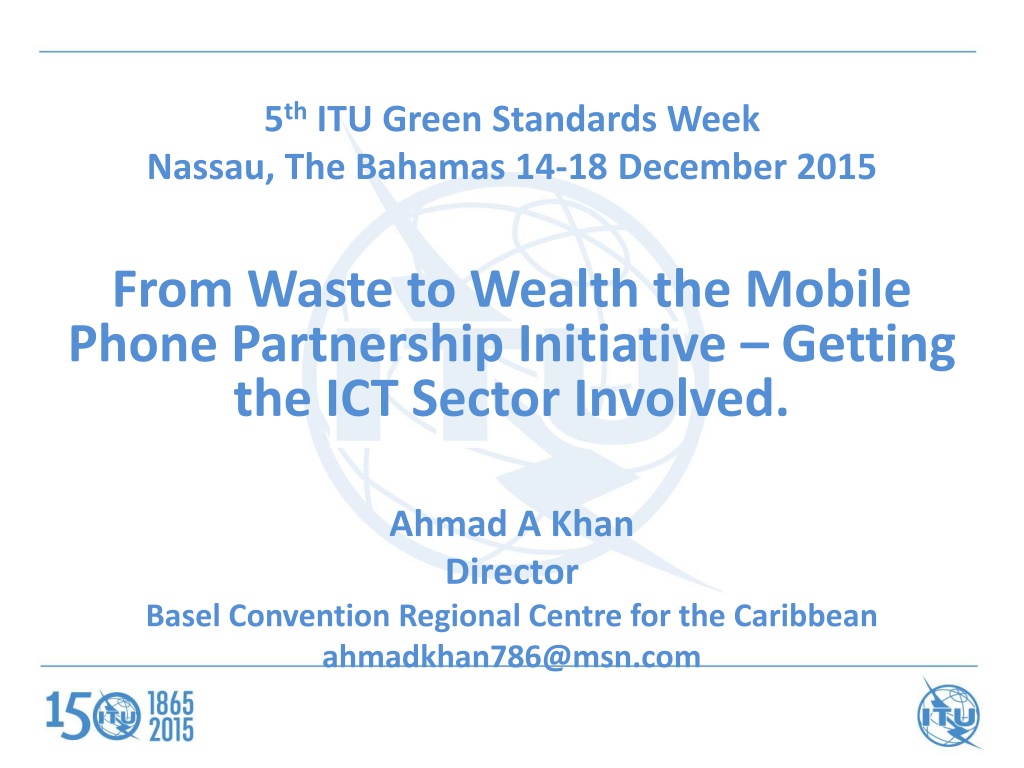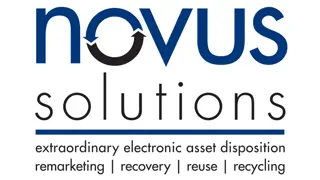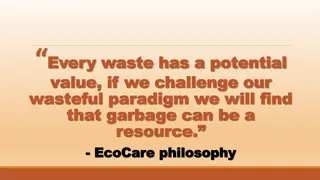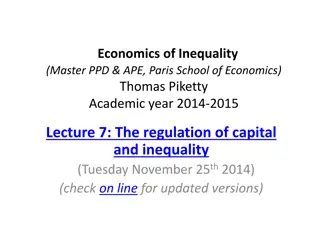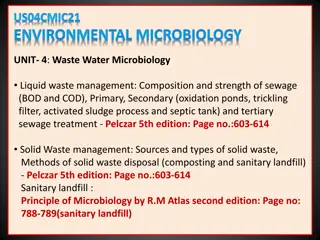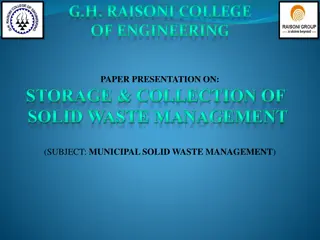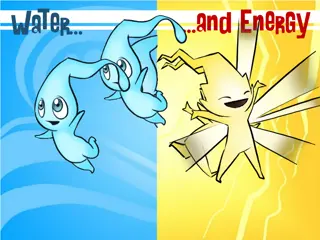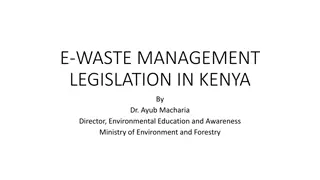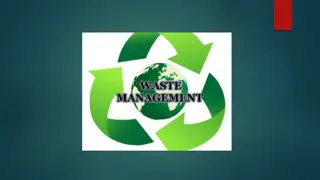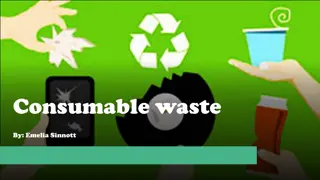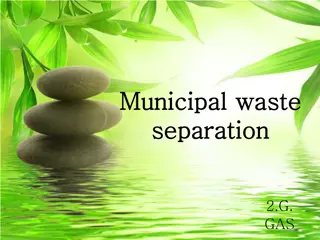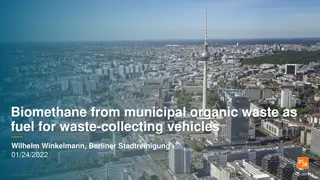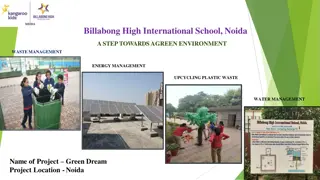Transforming Electronic Waste into Sustainable Wealth through Responsible Mobile Phone Management
The 5th ITU Green Standards Week in Nassau explored innovative ways to repurpose mobile phones, highlighting the valuable metals and potential environmental hazards present in these devices. The event emphasized the need for proper disposal practices in the Caribbean to mitigate pollution and economic losses. By promoting collection, refurbishment, and recycling, the initiative aims to turn electronic waste into a sustainable resource while involving the ICT sector in a crucial partnership for environmental protection.
Download Presentation

Please find below an Image/Link to download the presentation.
The content on the website is provided AS IS for your information and personal use only. It may not be sold, licensed, or shared on other websites without obtaining consent from the author. Download presentation by click this link. If you encounter any issues during the download, it is possible that the publisher has removed the file from their server.
E N D
Presentation Transcript
5th ITU Green Standards Week Nassau, The Bahamas 14-18 December 2015 From Waste to Wealth the Mobile Phone Partnership Initiative Getting the ICT Sector Involved. Ahmad A Khan Director Basel Convention Regional Centre for the Caribbean ahmadkhan786@msn.com
Introduction Mobile Handsets are typically composed of: 40% of plastic, 32% of non-ferrous metals, 20% of glass and ceramics, 3% of ferrous metals and 5% of other materials. Some 40 elements might be present, including base metals such as copper (Cu) and tin (Sn); special or critical metals such as cobalt (Co), indium (In) and antimony (Sb); and precious, platinum-group metals such as silver (Ag), palladium (Pd) and gold (Au).
Introduction For every tonne of Mobile Handsets (excluding battery) this equates to: 3% of Iron 16% of Copper 3.5 kg of silver, 340 g of gold, 40 g of palladium, and 30 kg of copper. Other constituents of concern for end-of-life management, such as bromine, lead, chromium and arsenic, are typically found in quantities of less than 1% content.
Introduction Mobile phones also contain plastics and halogens (including chlorine and bromine) which, when burned, lead to the formation of dioxins and furans, both highly toxic and carcinogenic. The batteries and re charger units also need to be properly managed. End- of-life batteries and any associated circuit boards or electronic assemblies containing Nickel/Cadmium alloys and lead-based solders have to be managed in an environmentally sound way.
Current Disposal Practices in the Caribbean Mobile Handsets Stored in place 50% Transferred to a Recycler 10% Disposed of in Landfills 40% Batteries and Chargers Stored in Place 50% Transferred to a Recycler 5 % Disposed of in Landfills 45%
Environmental Impacts of Current Disposal Practices Storage in Place Leakage of Batteries Landfilling Surface water and Groundwater Contamination Land pollution Air Pollution when burned in landfill fires Socio-economic Loss of Potential Revenue Stream
Waste to Wealth Collection and Reuse Environmentally sound management of used mobile phones has three goals to: Divert end-of-life mobile phones from waste streams destined for disposal in landfills or incinerators; Repair, refurbish and preserve used mobile phones in working order, so that they can be used again; and Channel unusable (end-of-life) mobile phones for environmentally sound material recovery and recycling.
Waste to Wealth Dismantling Only a small percentage of the millions of mobile phones retired and discarded annually are dismantled and recycled Large quantities of valuable metals end up either in storage or in landfills. If captured, the quantity of potentially recoverable metals would make a significant addition to the total recovered metals from recycling and would replace and supplement virgin metals currently extracted from mining.
Waste to Wealth Mobile phones contain a variety of substances that require sound handling and processing during material recovery and recycling, in order to prevent risks to workers, the public and the environment. Without appropriate health and safety procedures, including special provisions for hazardous wastes, impacts upon human health are likely to be severe. Dusts may be generated during the shredding of mobile phones, during the subsequent handling of shredder outputs and during the handling and/or processing of smelter slags. Toxic fumes may be generated during electronic components removal, metal sampling and similar processes, as well as during certain steps in plastics recycling, such as granulation.
Waste to Wealth Recycling Process Prior to material recovery and recycling of end-of-life mobile phones, several items need to be separated and sorted. Batteries must be removed before mechanical or pyrometallurgical processing, i.e., prior to any shredding and/or smelting. Accessories may also be sorted and separated from the mobile phone handset. The metals of economic interest and of environmental concern are mostly located in the electronic circuitry inside the handset. The extracted metals including gold, platinum, palladium and silver are later put back into productive use. High value materials make up about 16% (by weight) of a typical mobile phone.
Waste to Wealth Economic significance Reuse, refurbishment and recycling contributes significantly to the economic growth of countries. The goal of sustainability is to ensure that the nonrenewable resources are not wasted but kept in the material life-cycle as long as possible. Refurbishment and recycling also have an important socio-economic impact, particularly in developing countries. Door-to-door collection can be profitable as can refurbishment and resale. Recycling is an effective way to address resource scarcity and mitigate environment impacts associated with metal mining, processing and use, while at the same time it creates jobs and income while facilitating the product s life-cycle.
Getting the ICT Sector Involved Working with OEMs to includes design improvements to introduce reuse and recycling information into product marking, Working with OEMs to further reducing the use of hazardous substances, making reuse, refurbishment, material recovery and recycling easier and extending the life of products.
Getting the ICT Sector Involved ICT Service Providers to get involved in Handset Take-Back programmes as part of good corporate governance. ICT Equipment Manufacturers to also get involved in Extended Producer Responsibility Programs and Take-Back programmes.
Getting the ICT Sector Involved ICT service providers to support community level groups who want to invest in mobile phone recovery and refurbishment facilities. Assistance in the form of funding Assistance in the form of facilitating technical and HSE training. Providing access to new technologies for refurbishment.
Getting the ICT Sector Involved OEM to support Investment in dismantling and material recycling facilities. For the Caribbean this means establishing regional clusters and allowing the movement of e-waste from one country to the regional hubs. Encouraging certified recyclers to co-finance regional facilities. Guaranteeing a market for recyclable materials recovered at the business start-up stage.
Getting the ICT Sector Involved Further Information can be found at http://www.basel.int/Implementation/Technic alAssistance/Partnerships/MPPI/Overview/tab id/3268/Default.aspx
